- CITY HALL - 174 E. Wisconsin Avenue - 1886.
Designed by Milwaukee architect, George B. Ferry, it was originally the civic center of Oconomowoc and over the years housed city offices, the police and fire departments, and a community auditorium. Dances and plays were held on the second floor, which was later used as a courtroom and as city council chambers. City business is still conducted here. The City Hall building was placed on the National Register of Historic Places in 1980. The award-winning restoration/expansion of the building was completed in 1983 at a cost of approximately $1.8 million.
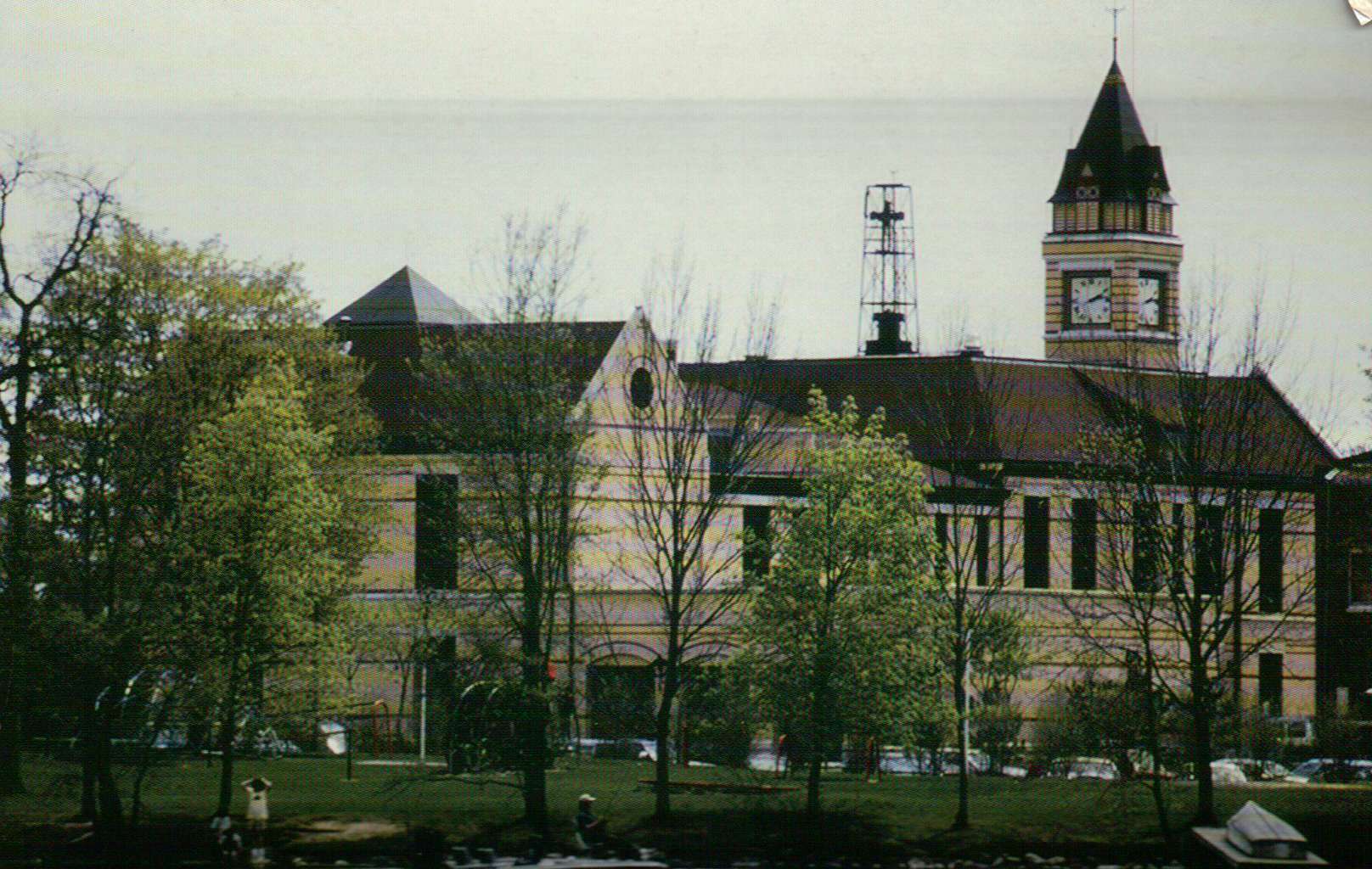
- WIZARD OF OZ PLAZA - 168 E. Wisconsin Avenue - 2019 - 2021.
We’re off to see the Wizard. Oconomowoc has a special relationship with the 1939 movie production of MGM’s classic film, The Wizard of Oz. The movie premiered on August 12th at the Strand Theatre before the “official” opening at Grauman’s Chinese Theatre in Hollywood on August 15th. According to an MGM spokesperson, the film studio wanted an idea of how middle America would react to the film. The movie was especially honored for its sound track and its pioneering use of a new process known as Technicolor. Periodically the city shuts down a portion of Wisconsin Avenue, sets up an enormous viewing screen at one end, and invites the community to enjoy the movie. Hundreds of adults and children once again are caught up in the story and music. In August, 2019, to commemorate the 80th anniversary of the premier, the City of Oconomowoc purchased these statues and renovated this space to depict the setting of the movie including the yellow brick road. The American Film Institute’s list of the 100 greatest films of all time ranks The Wizard of Oz as Number 6.
- CHASE BANK - 138 E. Wisconsin Avenue - c. 1875.
This early building once served as a livery stable for the townspeople, then later for the Jones House Hotel which stood on the corner west of here. By 1920, it became the Oconomowoc Wooden Toy Horse Company, maker of rocking horses. In 1925 the First National Bank purchased the building and substantially remodeled it, adding a façade of Bedford stone and Minnesota pearl pink granite. The name has been changed several times over the years, becoming Chase Bank in 2004.
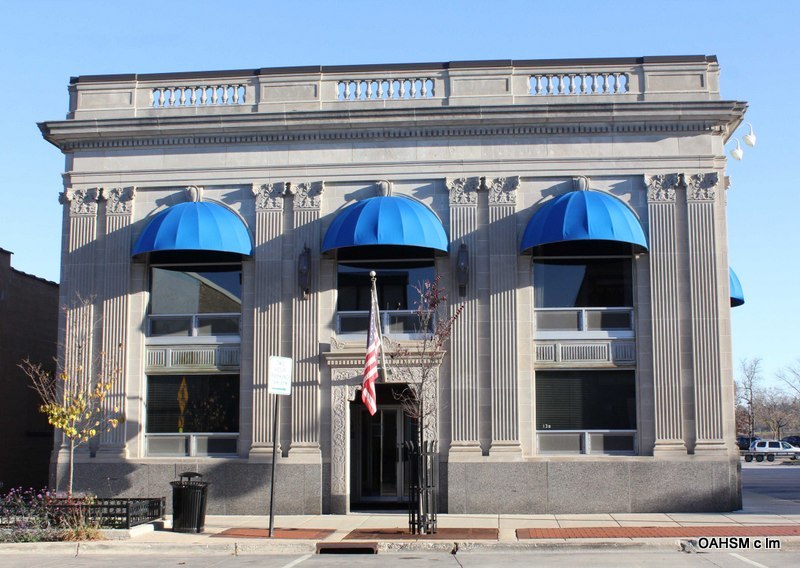
- VILLAGE GREEN - Northeast corner of Wisconsin Avenue and Main Street.
Several Indian trails crossed here, and until 1975 a hotel occupied the site. The first, the La Belle House, with white frame construction, opened in 1850. It was destroyed by fire in 1875, along with other portions of the downtown. After the fire, the lot was vacant until 1887, when a second hotel, the Jones House was built. It was updated and renamed the Majestic Hotel in 1915. It had a two-story open porch on two sides with the first floor used for dining and the second floor for hotel guests. In addition, local bands played from the second-floor porch for street dances held at the intersection. With a series of hotel owners, name changes, and renovations, the buildings on this site played a long and colorful role in city history. The last hotel, the Oconomowoc Inn, was condemned and razed in 1975. The Village Green is presently the site of many community activities.
![3.VillageGreen[1] #4 Village Green former LaBelle House, The Jones House, The Majestic Hotel and The Oconomowoc Inn](https://www.oconomowochistoricalsociety.org/wp-content/uploads/2022/07/3.VillageGreen1.jpg)
- FAY BLOCK - Southeast corner of Wisconsin Avenue and Main Street.
This triangular building constructed by George W. Fay in 1869 is one of the most iconic sites in the community. Originally constructed of brick, the exterior and interior have been remodeled several times. At the time this structure was built, the term “block” was used to denote a building that housed several units. Summit Bank, founded in 1859 and originally located in the Library Complex (#8), moved to this building in 1870 when space became available. After 115 years at this corner location, the bank moved to its current site one block west and is now known as Bank Five Nine, reflecting its founding date. Throughout its history, the bank has remained an independent, locally-owned community bank. Bank Five Nine is the second oldest bank in the state of Wisconsin. Since 1993 the headquarters for Rocky Rococo Restaurants has occupied the first floor, while other businesses can be found on the second floor.
![4-Faye-Block-750w[1] #5 Fay Block](https://www.oconomowochistoricalsociety.org/wp-content/uploads/2022/07/4-Faye-Block-750w1-1.jpg)
6. MANN BLOCK - 102-110 N. Main Street - 1871.
This three-story Italianate building has always included shops and businesses on the first two floors. In the past, the third floor was used for an armory, social gatherings, public meetings, and theatrical performances. Note the large double-bracketed cornices along the roof line, as well as the niche with the date 1871 on the east wall. An extensive renovation was completed in 2019, including new windows and a black façade on the street level as well as interior reconstruction.
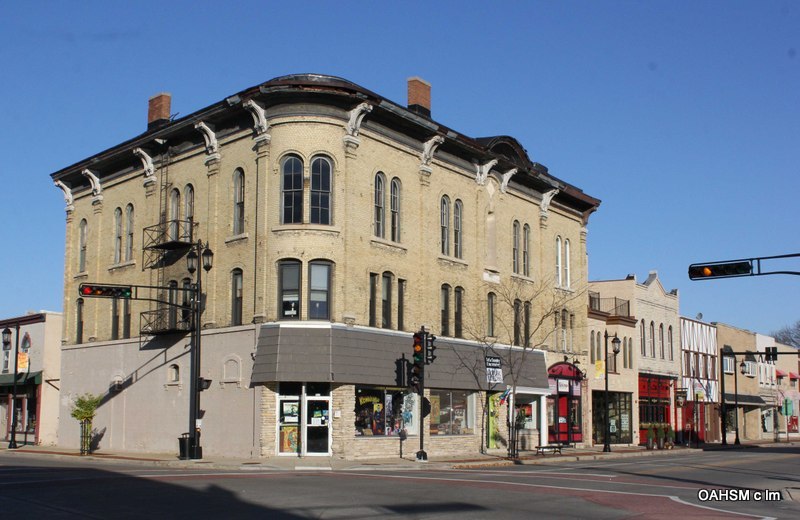
7. 125 - 139 N. Main Street.
This entire area was once the site of several significant early Oconomowoc businesses including the Peter Klos Saloon, Wegener’s Restaurant, Marine Railway boat shed, and Hugo Lorleberg’s Hardware Store. Established in 1870, Lorleberg’s occupied the center building at 131 N. Main St. until 1970 when it moved to a new building on E. Wisconsin Ave. Lorleberg’s is the oldest, continuously operating retail business in Oconomowoc.
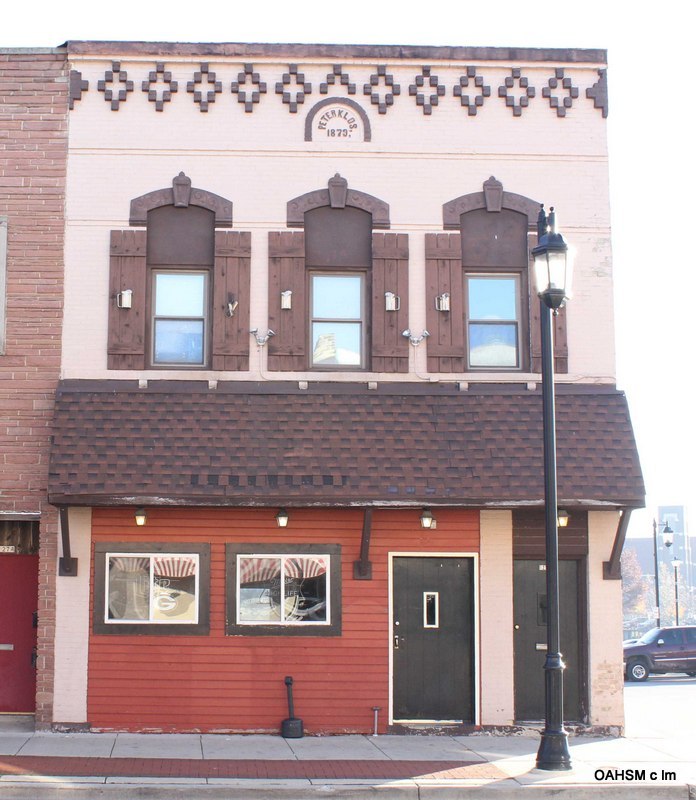
8. VETERANS MEMORIAL PARK - 200 N. Lake Road - 2015.
This community park honors all veterans, both living and deceased. The Oconomowoc Area Veterans Group, Inc. provided all services and costs connected to raising the money for the park’s completion. A three-story water-powered grist mill was located at this site from 1857 to 1936. In the early 1900s, a marine railway was built just to the north of the mill. The railway enabled an excursion and mail boat to be portaged across the two-hundred-foot isthmus between Fowler Lake and Lac La Belle. Also located north of the entrance to Veterans Memorial Park but razed in 1988, were three buildings known as the “Library Complex.” These buildings were considered Oconomowoc’s original downtown business district. Early businesses once housed in these buildings included a hardware store, a general store, a bank, City Hall, the post office, and the Telephone Co. among others. The Complex also served as the public library/museum for many years.
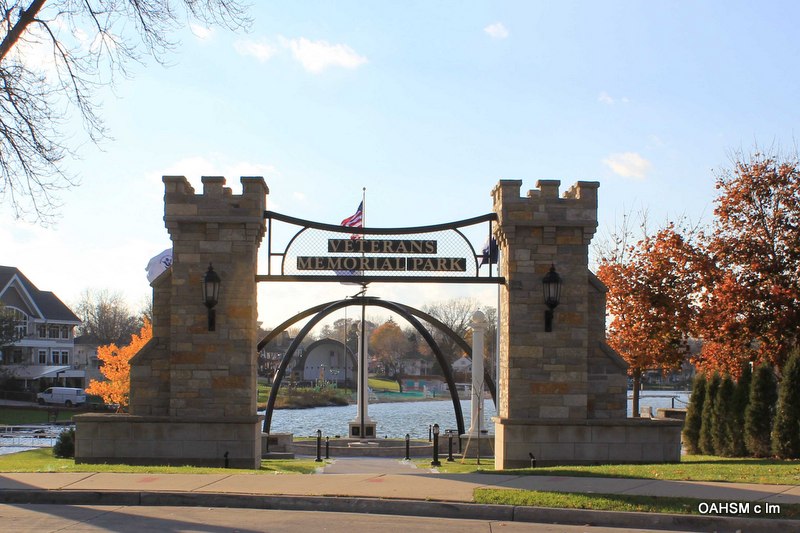
9. ZION EPISCOPAL CHURCH - 237 N. Lake Road - 1889.
The land for the church was donated by John S. Rockwell, the “Father of Oconomowoc” (#19). The Romanesque limestone church that you see here replaced an earlier red brick structure. Zion Episcopal’s beautiful peninsula setting on the lake is one of the city’s outstanding landmarks.
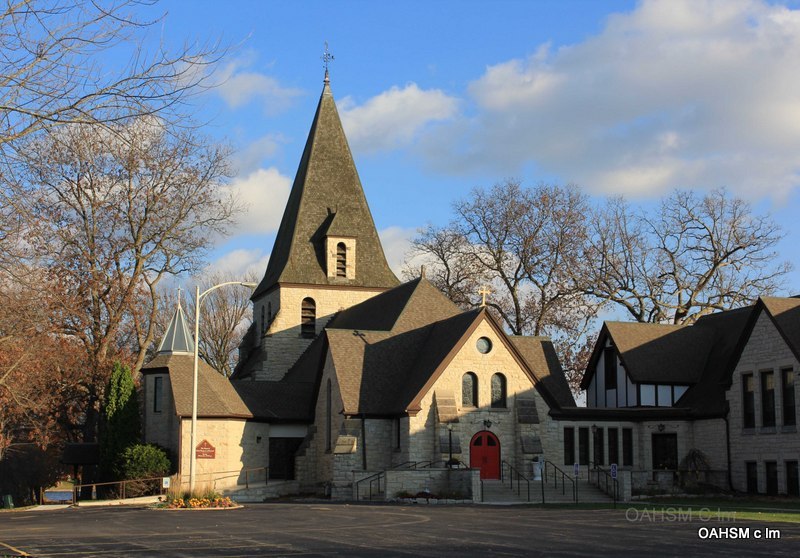
10. 238 N. LAKE ROAD - 1860.
The original structure was remodeled in 1899 by David Gould, a St. Louis millionaire. Inside, the sixteen-room mansion was fitted with eleven fireplaces. The once broad lot had sunken gardens and tennis courts. It has gone through at least two renovations since that time.
11. 307 N. LAKE ROAD - c. 1895.
Built by Captain John Scudder from St. Louis as a summer home, the house has a huge veranda on 2 sides that makes it appear half again as large. It was known as “Scudder’s Cottage,” and remained in the family until around 1920 when it was purchased by Caroline Kohl, prominent Oconomowoc resident. In 1922 the Freemasons purchased the mansion to be used as their lodge for the next 92 years. Extensive remodeling from 2016 - 2019 by new owners returned the mansion to its former glory. Notice the exceptional widow’s walk on the highest point of the home, the oval window in the triangular gable, and on the south side, the beautiful porte-cochere, a roofed structure that allows vehicles to pass through.
![317-Lake-Road[1] #11 307 N. Lake Road](https://www.oconomowochistoricalsociety.org/wp-content/uploads/2022/07/317-Lake-Road1.jpg)
- 317 N. LAKE ROAD - 1889.
Built by H. G. Brookings, a St. Louis businessman, the Queen Anne-style mansion was used as a summer home for the family until the 1920s. By 1955 the third floor and part of the second floor had been converted to apartments. The massive three-story octagonal tower has an unusual porch, opening on three sides on the top floor.
13. 318 N. LAKE ROAD.
This was the former site of the Harold Peck mansion. Harold was one of the sons of Madame Peck (#18). He died during construction of the mansion. The home was completed by his widow at a cost of $15,000 becoming one of the most expensive mansions in the area at that time. In 1991 the home was razed and a condominium built in its place.
![13.318LakeRoad21[1] #13 318 N. Lake Road](https://www.oconomowochistoricalsociety.org/wp-content/uploads/2022/07/13.318LakeRoad211.jpg)
14. 333 N. LAKE ROAD.
Formerly the site of Draper Hall, a small roadside hotel, which was later remodeled into a large, rambling hotel with a seven-column colonnade across the front. The columns were three stories tall. Famous guests included Grover Cleveland, Spencer Tracy, and Marshall Field. In the 1870s, it had forty-six rooms, later remodeling doubled that number. The hotel passed through several owners and was finally razed in 1967. Draper Hall Condominiums were built in 1972.
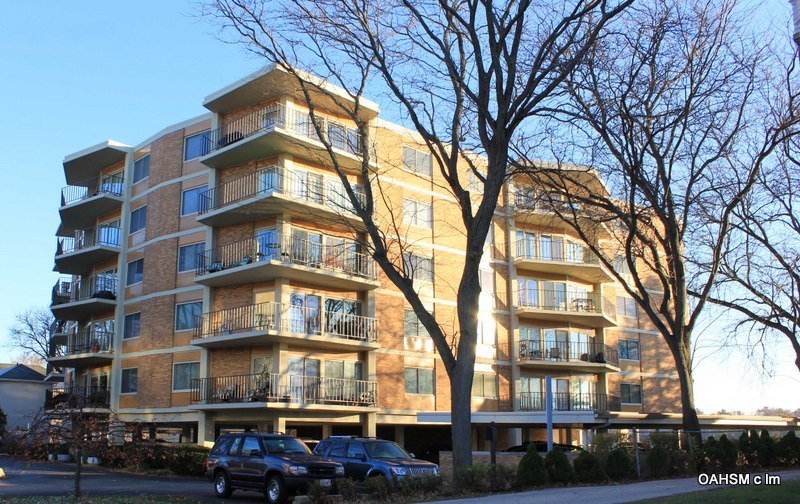
15. 404 N. LAKE ROAD - 1882.
This was the home of J. C. Hitchcock, who was in the hardware business. The grounds had a large mineral spring which furnished the home with drinking water from cellar to garret. The Swiss Cottage style home was designed by Milwaukee architect James Douglas, as was its next door neighbor (#16). Both homes have the same floor plan.
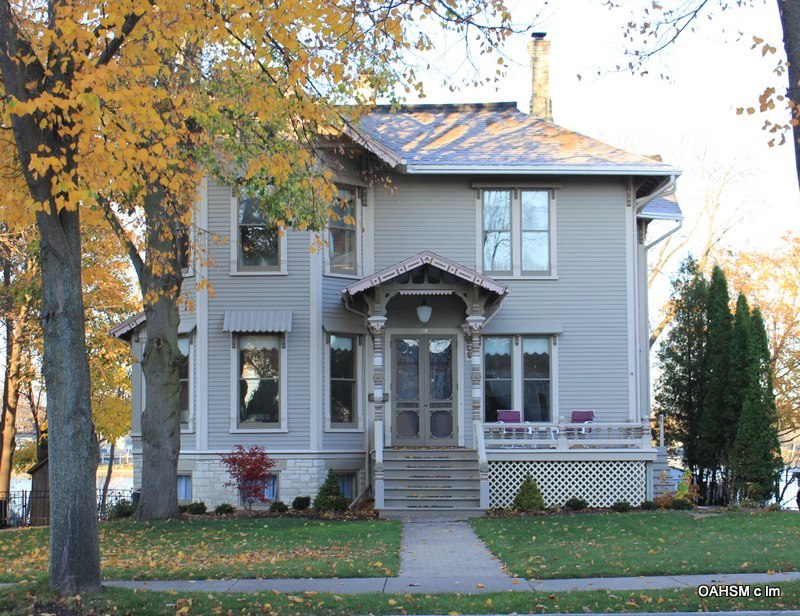
- 412 N. LAKE ROAD - 1881.
In 1879 Mr. Martin B. Medbery transferred the property to his wife, Eunice. Built by Mrs. Medbery, this house with its roof and stick-style gable is typical of Douglas’ work (#15). In 1942 Catherine Clark, founder and owner of Brownberry Ovens, and her husband Russell, purchased this residence. Many recipes for her nationally recognized breads were developed in the kitchen of this N. Lake Road home.
- 423 N. LAKE ROAD - 1884.
This Queen Anne Revival style home was built by G. W. Fuller of Chicago. The north wall has an unusual window layout, a scroll-cut decorative panel at the third-floor level, and ornamental shingle siding.
- 430 N. LAKE ROAD - 1846.
The southern portion was built in 1846 by Martin Townsend for his son, Dr. Hosea Townsend, the city’s first resident physician. In the 1850s, it was purchased by Dr. William Warner, who built an addition to the north. Later, Rev. Ezra Jones, rector of Zion Church, purchased the property, added a second story on the north end, and opened a school for boys. The property was purchased by Dr. Orlando W. Wight in 1869, but was sold again in 1872 to Mary K. Peck, aka Madame Peck, the widow of Philip F. W. Peck, who had acquired great wealth in early Chicago real estate. Mr. Peck died from injuries sustained during the Great Chicago Fire of 1871. Madame Peck became one of Oconomowoc’s greatest boosters. She sold the home to her son Clarence who added the ten Ionic columns, reportedly from the 1893 Chicago Columbian Exposition. This was the last major expansion of the home. The gazebo on the shoreline was part of a judging stand for yacht races. In 1923, the mansion was sold to John and Lenore Stevens. They divided the house in 1927 and sold the original southern portion, which was remodeled in 1979. The northern building was later remodeled in 1988. Both houses were added to the National Register of Historic Places in 1988. The two sections of the house were rejoined in 2010.
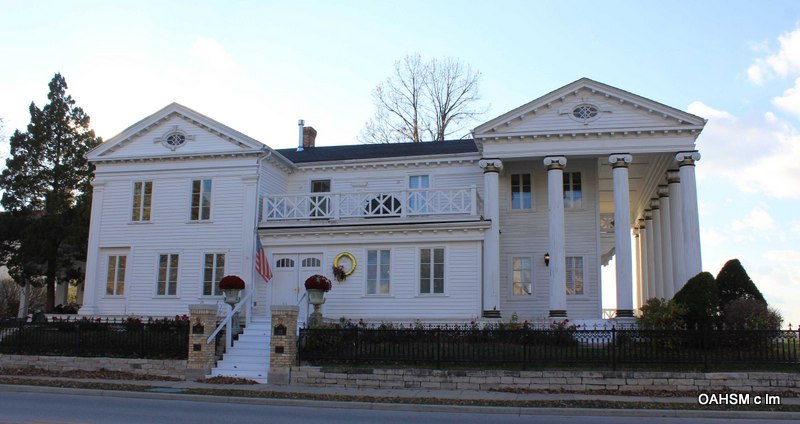
19. 517 N. LAKE ROAD - JOHN AND LAVINIA ROCKWELL PARK - 2021.
The first house in the village, a log cabin, was erected on this site in 1837 by Philo Brewer. A few years later, John S. Rockwell (#9) and his wife Lavinia purchased the property and lived here together until Lavinia’s death in 1852. John Rockwell continued to reside here with his second wife Anna until he died in 1863. The park honors the Rockwell Family for its many contributions to the Oconomowoc community. In his lifetime, Rockwell and his partners financed a grist mill, a dam, a lumber mill as well as donating land to the Methodist, Catholic, Episcopal, and Baptist congregations. In addition, Rockwell gave land for a girls’ boarding school and the Oconomowoc Cemetery.
- N. LAKE ROAD DAM.
The first dam was built in 1837 near where the bridge is today, but it washed out and was rebuilt several times. A sawmill and gristmill were also located here. A navigational lock, which was used to raise and lower boats was built between the two lakes in 1885, and later demolished because the locks drew down the level of the lake to such an extent that the operation of the flour mill was affected. The locks were not rebuilt.
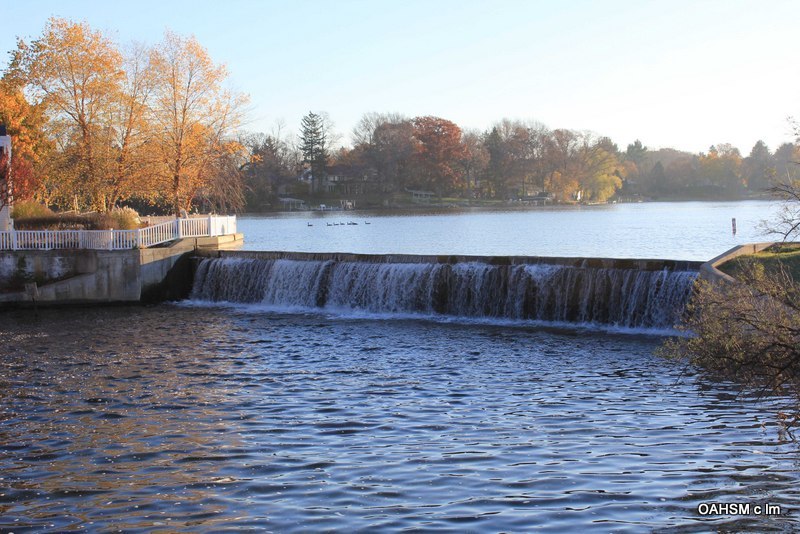
- KNOLLWARD - 800 N. Lake Road - 1928.
This imposing mansion has been called the finest example of French Provincial architecture in the Midwest. It was built in 1928 by Marjorie Ward, the adopted daughter of mail order mogul A. Montgomery Ward of Chicago. The original cost was $80,000. A north addition was constructed in 1932 after Marjorie’s marriage to Robert Baker. In 1961, the estate was donated to Shorehaven, a local continuing care senior campus, including a large sum for construction of a two-story addition and interior remodeling. Knollward then served as a residential care facility until 1996. In 1998, the original property was divided into four lots, all of which, including the Marjorie Ward Baker home, are now privately owned.
![Knollward-5[1] #21 Knollward](https://www.oconomowochistoricalsociety.org/wp-content/uploads/2022/07/Knollward-51.jpg)
- 128 E. LISBON ROAD - c. 1873.
This Gothic Revival house was once home to Emory A. Clark, a Chicago furniture manufacturer. It was moved to this site from the east shore of Lac La Belle. Many additions have changed its original design. However, unique lancet windows framed by pierced, scroll-cut bargeboards on the gables remain.
23. THE INN AT PINE TERRACE - 351 E. Lisbon (viewed from Greenland Avenue) - 1879.
This Gothic Victorian mansion was built as a summer home by Peter and Henry Schuttler, Chicago wagon manufacturers. The Schuttler brothers married into the brewing families of Anheuser and Busch. The estate included about 160 acres of forest and farmland. A large flower garden and lawn area once connected the mansion with the north shore of Fowler Lake. In 1988, the mansion was extensively renovated and operated as a thirteen-room bed and breakfast inn. Condominiums now occupy a significant portion of the original grounds. Pine Terrace was placed on the National Register of Historic Places in 1987. Currently additional renovations are in progress with the bed and breakfast inn scheduled to open in July 2022.
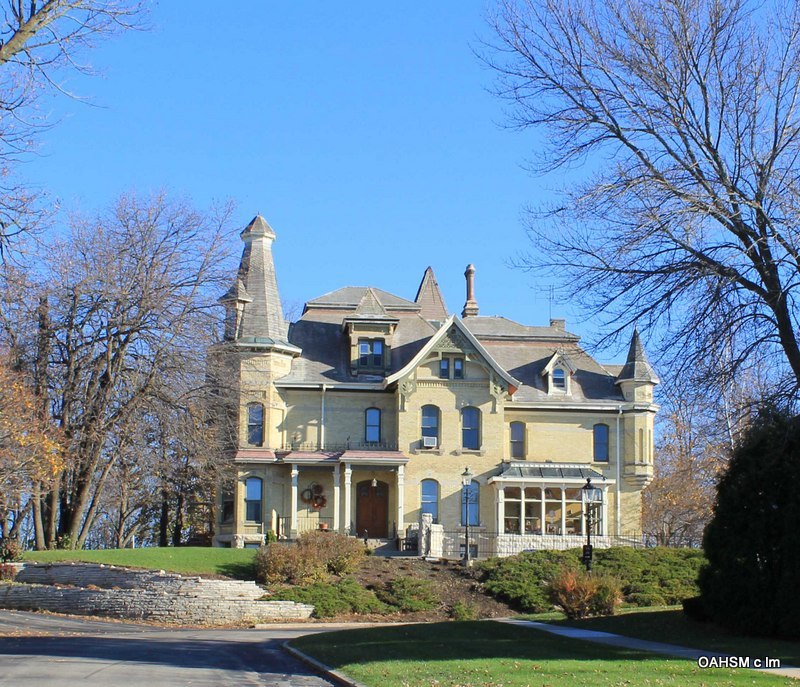
- FOWLER PARK - 500 Oakwood Avenue.
Prior to 1851, a portion of this park served as a cemetery. The property changed hands several times before it was purchased in 1864 by Dr. James A. Henshall, M.D. On this site in 1868, Henshall developed America’s first private fish hatchery which specialized in propagating black bass. The coach house is all that remains of a once spectacular estate. In 1945, this site was donated to the city as a park by sisters Ida M. Binzel and Anna Binzel Theobald, members of an early Oconomowoc family.
- CORNERSTONE CHURCH LAKE COUNTRY - 354 N. Oakwood Avenue -1872-1883.
A congregation of Norwegian Lutherans began building this church in 1872, but it was not completed until 1883. According to church records, it was known as Our Savior’s English Lutheran Church from 1883-1953. When the Lutheran congregation built its new church at Lisbon Rd. and Greenland Ave., this building was rented by the Alliance Bible Church, services being held here until 1978. Abundant Life Church rented the property through June of 1979, later purchased the building, and remained at this site until July of 1996. Currently Cornerstone Church Lake Country occupies this site. The painted stained-glass windows are original.
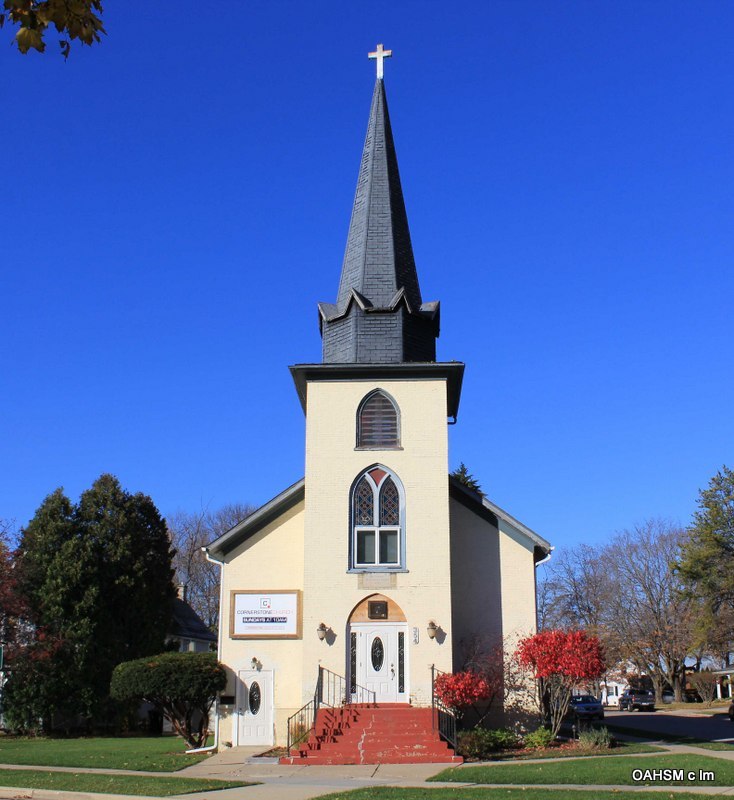
- 344 N. OAKWOOD AVENUE - c. 1880.
This little cottage belonged to the Townsend House, a grand hotel, which once stood northwest of the Oakwood Avenue Bridge, commonly known as the Norwegian Bridge. The hotel which burned in 1901 had been the summer destination for Chicago society and was the scene of many gala social events of the era. This charming Carpenter Gothic home was used by the hotel as a guesthouse. It originally had no kitchen since guests took all their meals at the hotel.
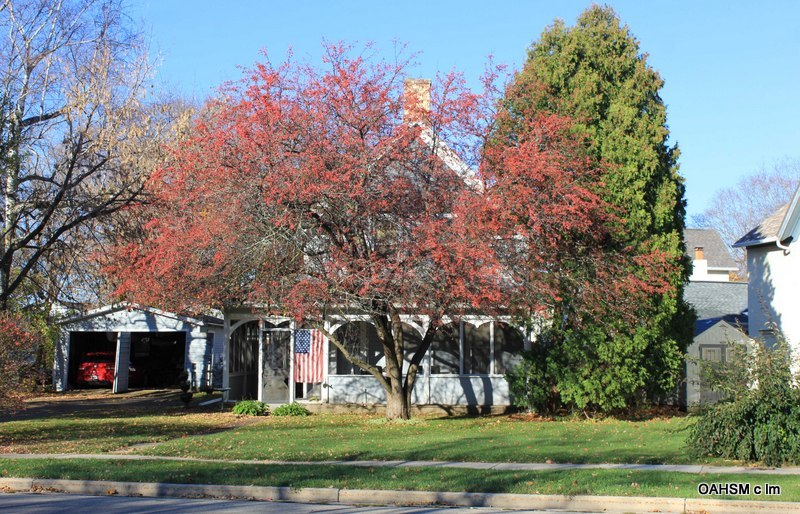
- OCONOMOWOC DEPOT - 115 Collins Street - 1896.
Although not directly on this Fowler Lake Walking Tour, the Depot is noted because it is one of the most important landmarks of the city. The first freight and passenger depot, located one block east of this building overlooked the stockyards. Oconomowoc summer residents, Albert Earling, President of the Milwaukee, Chicago & St. Paul Railroad, along with Philip D. Armour, wealthy Chicago meat-packer, were instrumental in having this passenger depot built. The previous facility, was considered unsuitable for the reception of their wealthy, distinguished guests. Train services ceased in 1976. The Depot was listed on the National Register of Historic Places in 1980. It is presently used as a restaurant.
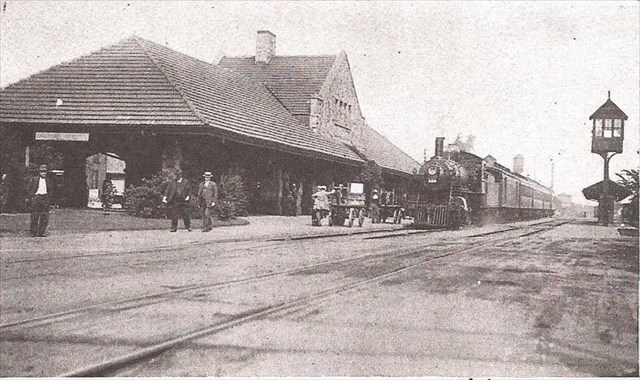
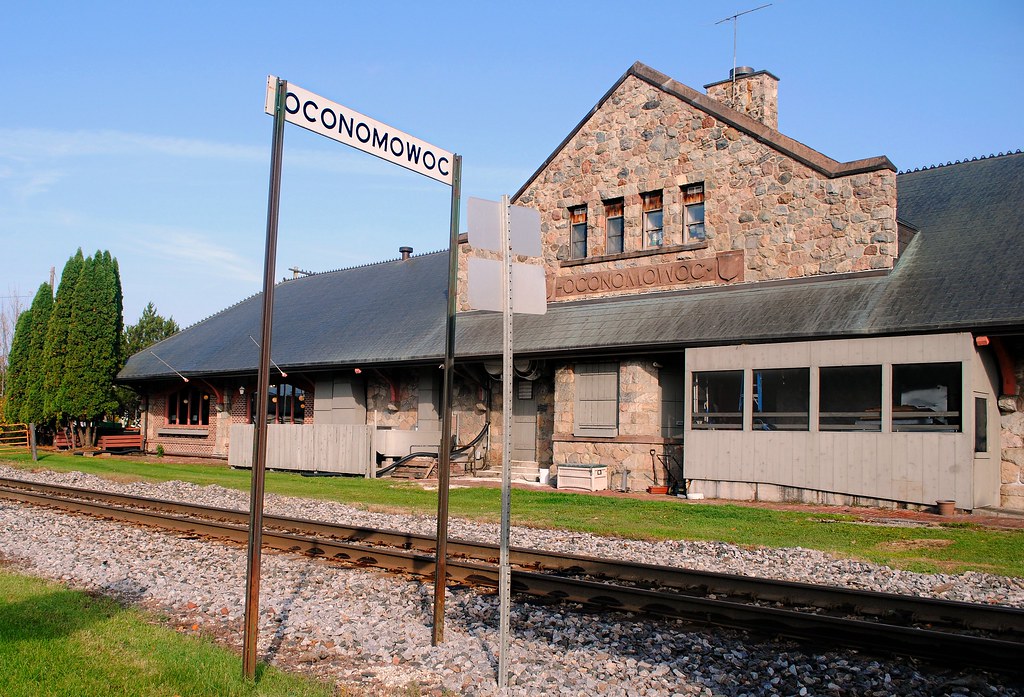
Acknowledgments
The lake walk tour was originally compiled by Fran Brummit-Durkin and Rae Kinn circa 1990s.
Updated by Barb Elwood-Goetsch and Barb Hirsch, ©2022
Resources
Barons to Bootleggers, Barbara and David Barquist, © 2006
The Heritage Guide Book, Landmarks and Historical Sites
In Southeast Wisconsin, Russell Zimmermann, 1976, 1989
Questers’ Guide to Historic Oconomowoc, © 1990, Third Printing, Spring 2007, J.S. Rockwell Chapter #721 The Questers, Inc.
* For more information, visit the museum or contact:
Oconomowoc Historical Society
P.O. Box 245, Oconomowoc, WI 53066
Phone: (262) 569-0740
